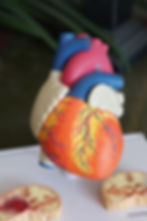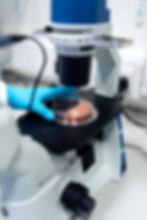
Have you ever wondered how our hearts beat? While many of us know that our body, including our heart, is made up of many cells, not all cells can produce a regular heartbeat.
As it turns out, there is a special kind of heart cell called cardiomyocytes that is primarily involved in the contractile function of the heart and allows blood to be pumped around the body. In what is known as the contraction-relaxation cycle, cardiomyocytes regulate the beating of the heart through increases and decreases of calcium ion levels in the cells, which are small charged molecules that travel in and out of the cell membrane corresponding to each heartbeat (Woodstock et al., 2005).
There are many steps involved in this complex process of regulating the changing levels of calcium ions. As we age, our heart cells become less efficient at keeping up this complex system. As a result, people are more easily susceptible to heart disease.
A common disease is heart arrhythmia, which involves irregular beating of the heart. In some individuals, their hearts may skip a beat or two from time to time, and in others, their hearts may consistently beat faster or slower than normal. All of these can be attributed to the malfunctioning of the complex process of cardiomyocytes’ role in the contraction-relaxation cycle The causes of and treatments for heart arrhythmia are still an active area of research among scientists.
In the 1990s, scientists began studying embryonic chick cardiomyocytes. They took fertilized eggs, extracted some cardiomyocyte cells, and observed them under the microscope (Eschenhagen et al., 1997). While they were cool to look at, scientists realized that they were difficult to work with. After all, chickens are different from humans, and many human heart diseases cannot be easily translated to other species.

In 2006, a new technology emerged. Shinya Yamanaka, a Japanese scientist, discovered a set of 24 transcription factors, also known as Yamanaka Factors, which are proteins that regulate what type of cells a particular cell is or will grow into. These Yamanaka Factors, in particular, are able to turn mature somatic cells, such as skin cells and heart cells that already have a distinct function, into induced pluripotent stem cells (iPSCs), which have the power to grow into many other types of cells (Takahashi et al., 2006). Using Yamanaka Factors, scientists can now take a sample of skin cells from a patient with a particular heart diseases, reprogram these cells into iPSCs, and grow them into cardiomyocytes on a dish, and study the patient’s “heart” from the lab (Karakikes et al., 2016).

In recent years, Dr. Thomas Eschenhagen from University Medical Center Hamburg has been using iPSCs to build 3D heart tissue models for testing and cardiac repair. First, by using different combinations of Yamanaka Factors, he grows iPSC-derived cardiomyocytes on 3D printed scaffolds. The design of these scaffolds requires careful consideration because, in the body, cardiomyocytes are arranged in a specific structure to form heart tissue via the extracellular matrix, which is a series of proteins that puts different cells in place so the cells can function properly with the appropriate spatial proximity to other cells. The scaffolds that Dr. Eschenhagen seeks to mimic is the 3D extracellular matrix to make sure the cardiomyocytes are growing in an environment as similar as possible to their native heart environment and to ensure the growing heart cells are easily observable by existing lab technologies so that he can monitor and compare how well each set of cardiomyocytes are growing (Weinberger et al., 2017).
Dr. Eschenhagen not only hopes to model heart tissues in a dish, he also hopes to use iPSCs to create stem cell therapies for cardiac repair. At the start of his iPSC research career, he could not even imagine how they can be used to repair the heart. However, after growing more heart tissues in the lab, he began to see hope for using iPSC-derived cardiac tissues to treat damaged hearts.
Myocardial infarction, or commonly known as heart attacks, leads to irreversible cardiac damage that greatly scars the heart muscles. Naturally, cardiomyocytes have less than 1% regeneration rate each year, which is very slow and insufficient to recover from large-scale damage that the heart undergoes during a heart attack (Eschenhagen et al., 2017).
To address this, scientists tried transplanting human embryonic stem-cell-derived cardiomyocytes into non-human primate Macaca nemestrina who had survived heart attacks, and saw a significant improvement in heart function (Liu et al., 2018). In this direction, Dr. Eschenhagen continues to study whether iPSCs can be used to repair heart damage. Specifically in guinea pigs, Dr. Eschenhagen induced myocardial infarctions, seeded iPSCs, and observed the hearts after transplantation (Weinberger et al., 2016). He was able to observe improved heart function in the guinea pigs, which shows great promise in the ability of using iPSCs to treat damaged heart tissue.
Today, heart disease is the leading cause of death in the world. The discovery of induced pluripotent stem cells shows great promise in future personalized stem cell therapy, where cells from patients can be directly used to regenerate healthy, functional tissues in the lab and transplanted back into the patient to repair any major tissue damage, including the heart. While the current research has shown great promise in non-human organisms, more work is needed to translate this technology from non-humans into humans. With the continued research and experiments by Dr. Eschenhagen and many other stem cell scientists and engineers, we can hope to one day use our own cells to create personalized stem cells that can be used to treat ourselves, thus eliminating the need for organ transplants from others, greatly reducing the possibility of our bodies’ immune systems rejecting transplants, and save more lives.
Works Cited
Eschenhagen, Thomas, et al. "Cardiomyocyte regeneration: a consensus statement." Circulation, vol. 136, no. 7, 2017, pg. 680-686.
Eschenhagen, Thomas, et al. "Three‐dimensional reconstitution of embryonic cardiomyocytes in a collagen matrix: a new heart muscle model system." The FASEB journal, vol. 11, no. 8, 1997, pg. 683-694.
Takahashi, Kazutoshi, and Shinya Yamanaka. "Induction of pluripotent stem cells from mouse embryonic and adult fibroblast cultures by defined factors." cell vol. 126, no. 4, 2006, pg. 663-676.
Karakikes, Ioannis, et al. "Human induced pluripotent stem cell–derived cardiomyocytes: insights into molecular, cellular, and functional phenotypes." Circulation research, vol. 117, no. 1, 2015, pg. 80-88.
Liu, Yen-Wen, et al. "Human embryonic stem cell–derived cardiomyocytes restore function in infarcted hearts of non-human primates." Nature biotechnology, vol. 36, no. 7, 2018, pg. 597-605.
Weinberger, Florian, et al. "Cardiac repair in guinea pigs with human engineered heart tissue from induced pluripotent stem cells." Science translational medicine, vol. 8, no. 363, 2016.
Weinberger, Florian, Ingra Mannhardt, and Thomas Eschenhagen. "Engineering cardiac muscle tissue: a maturating field of research." Circulation research, vol. 120, no. 9, 2017, pg. 1487-1500.
Woodcock, Elizabeth A., and Scot J. Matkovich. "Cardiomyocytes structure, function and associated pathologies." The international journal of biochemistry & cell biology, vol. 37, no. 9, 2005, pg. 1746-1751.
Last Fact Checked on May 28th, 2021.
